Basic Tips and Tactics
It is said that chess is 10% strategy and 90% tactics, but those percentages change as you get more and more experienced at the game.
Let's get to some of the important tactics, including a list of important tips that can help build your strategy, as well as some important tips that must be followed in order to succeed.
Tactics
A tactic in chess is one critical move or a sequence of moves that can gain a player a helpful advantage. Some tactics can lead into capturing your opponent's pieces without giving up any of your own pieces, or some tactics can bring your player at a disadvantage. Other tactics would involve finding a checkmate to completely win the game!
There are some examples of some beginner tactics that can be used to gain such an advantage for you.
The Pin
The pin is a tactic where a piece is on the same diagonal or line as a higher-valued piece, which means that the piece cannot move without discovering an attack to the higher-valued piece.
Sometimes, this tactic can be an attempt to prevent an opponent from getting a better position.
Example 1
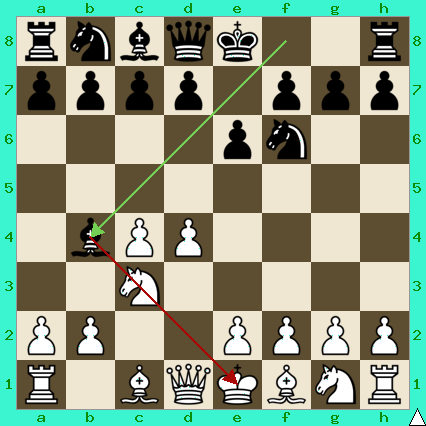
Black's bishop pins the knight to the king.
In the following position, the last move black has played was bishop on f8 to b4, pinning the knight to the king. This move makes it so that the knight cannot move without discovering an attack to the king. In this case, any move from the c3 knight is outright illegal because the king would be in check, allowing for the black bishop to take the king on the next move. If the White player tries to attack the bishop with the pawn by moving it up to a3, black can take the knight. You might ask why, but when white recaptures the bishop with the b2 pawn, you can see that white has doubled pawns and a weak pawn structure on the queen side.
But how can that pin be used to gain a bigger advantage?
Example 2
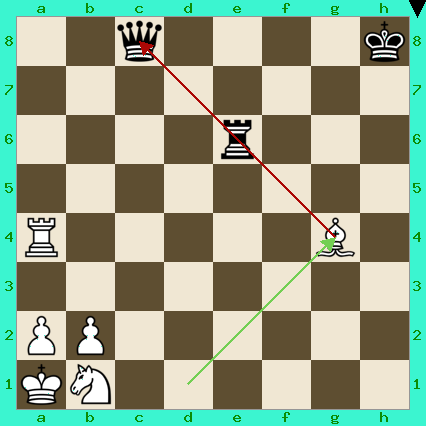
White's bishop pins the rook to a queen.
The bishop pins the rook to the queen, and this means that the black rook can't be moved without discovering an attack to the queen, a much higher-valued piece than the rook. In the next move, White would be happy to capture the rook, because the rook is worth more than a bishop.
The Skewer
A skewer is similar to a pin, except the piece with the higher value is in the front than in the back. This tactic can gain huge amounts of material and a crushing advantage for the player.
Example 3
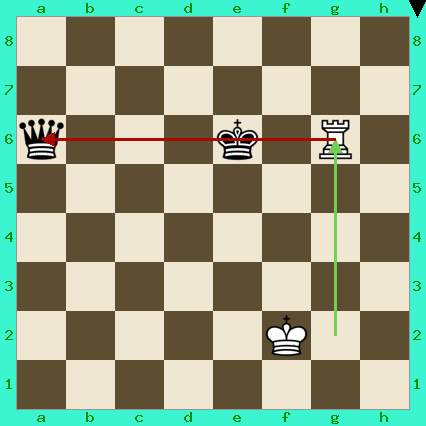
White's rook skewers the king and the queen, which are on the same rank.
The last move played by white is rook from g2 to g6, putting the king in check. The king has to move away from the attack, which is the 6th rank, so the king must either move to the fifth or the seventh ranks. That discovers an attack to the queen, which the white rook can take for no other piece.
A pin or a skewer can be given two different names. If the higher-valued piece in the pin or the skewer is the king, the move is known as an absolute pin or skewer. If the higher-valued piece in the pin or the skewer is not the king, the tactic is known as a relative pin or skewer. The pin in the first example is known as an absolute pin, while the pin in the second example is known as a relative pin.
The Fork
Another basic and deadly tactic in the game of chess is the fork. This tactic is very deadly, because it attacks two of the opponent's pieces at once.
Example 4

Black moves his knight to a3, forking the queen and the rook.
The last move played by black is knight on b5 to a3, forking the queen and the rook. White can only move one of those pieces, and white will either be losing the queen or the rook. Instead of knights, forks can be done by all the other pieces, as well. Most commonly, you would see forks with pawns.
Discovered attacks
Another deadly tactic is known as a discovered attack, which means that, when a piece moves out of the way, a piece that can move long discovers an attack to another piece.
Example 5
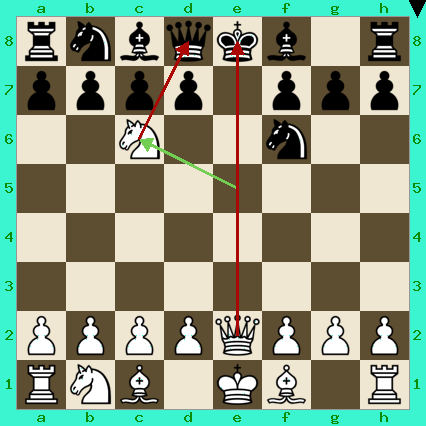
The last move played by white was moving the knight from e5 to c6, where the queen discovers an attack to the king, and the knight attacks the queen at the same time. No matter what the next move is, White's knight can then be happy to capture the queen, and giving up a knight to win a queen gives an advantage to white.
Forcing a Stalemate
Not all hope is lost when you're losing the game. Sometimes, you can find an important sequence where you can get a stalemate, and you can make a draw out of it!
Example 6: The black rook delivers check to the king.
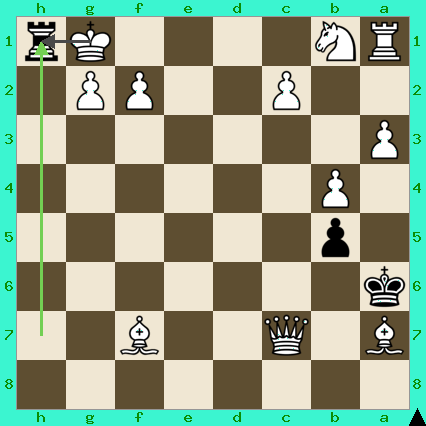
The only move is for the king to take the rook, and the position is a stalemate.
The last move played by black is moving his rook from h7 to h1, delivering check to the king. The only way to respond to the check is by taking the rook, and black needs to make another move. Black's king isn't in check, but black doesn't have legal moves for neither his king nor his pawn. So, this means that the position is a stalemate and the game is a draw. These are one of the reasons why you shouldn't resign.
Important tips and principles that can help build your strategy.
Tips for the Opening
The opening is always the start of the chess game. This is where we start to see the iconic opening position, and see how players will start the game with all of their pieces ready for battle. You already might be freaking out and be thinking, "I'm stuck. What's up with all of these pieces? How do I start?" These tips will tell you how to get an advantage in the first few moves of the game.
- 1. Move your pieces, such as your pawns, towards the center of the board, controlling the center squares.
- - The center squares of the board, which are d5, e5, d4, and e4, are very important to gain control of right away. From there, you want to either move the pawn in front of your king or your pawn in front of your queen two moves up to gain space of the center of the board. Usually, your opponent will try to do the same. Controlling the center squares are important because your pieces are much more mobile in the center than in the sides. A knight on the center of the board can move eight squares, whereas a knight on the side of the board can only move four. The same applies to other pieces such as rooks.
- 2. Develop your knights and bishops first.
- Beginners might think that developing their queen first is a good idea, but it isn't, because the opponent would be able to attack the queen while developing their knights and bishops towards the center. Start by developing your knights, and then your bishops, and eventually to the major pieces, which are the rooks and your queen.
- 3. Never bring your queen out too early.
- For the same reason mentioned on tip 2, bringing your queen out isn't too early. Sometimes, a devastating tactic might be done and you might not be able to move your queen, because either the queen is trapped, or your king is in or will be in check if you moved the queen.
- 4. Be sure to protect your king by castling.
- The main goal of chess is to checkmate the king, and it's important that you keep your king safe, because the loss of the king means the loss of the game. This is why castling is a perfect idea most of the time, mostly on the king side. Also, the pawns in front of the castled king are like the "wall" your king hides behind. Advancing these pawns exposes the king more, and weakens the kingside more for you, and that weak kingside can be a target for your opponent.
- 5. Don't move the same piece too many times.
- Moving the same piece too many times will slow down the development of all of the pieces. You want to bring all of your pieces towards the center of the board, instead of just one, because your opponent can take these extra moves to get a lead in deveopment. Instead, you want to develop all of your knights and bishops as fast as you can.
- 6. Don't make too many moves with your pawns.
- Once again, your opponent can then gain a lead in development if you make moves with your pawns instead of all of your other minor pieces. Only make extra moves with your pawns if they directly attack pieces without hanging any of them.
- 7. Once your knights and bishops are developed, that is now a time to develop your rooks and your queen.
- Controlling the center, developing your minor pieces, and castling your king are just the first three steps on reaching the fully-deveoped position. Once you are through with all three of those steps, now is a great time to activate the rest of your pieces, such as your rooks and your queen. You might have already used some of the pieces to make certain tactics, which is completely fine.
- 8. Don't open with pawns on the sides of your board, even if you want to develop the rooks right away.
- This one is very important. Many complete beginners would like to develop the rooks early by pushing their side pawns first, but that plan almost never works. Once again, the pawns should be moved to the center of the board, in order to gain control of the important center squares.
- 9. You can also develop a bishop along a long diagonal, known as a fianchetto. This does require moving your knight pawns one space up, because moving the pawn up two squares will make the pawn, as well as the squares around the pawn, weak and easy to attack.
- The fianchetto is also another good way you can develop your bishop. You can move your pawn in the file the knights are one space up, and then move the bishop one square diagonally to control the long diagonal. Not only the bishop controls a lot of space in the long diagonal, the bishop also controls two of the center squares as well, which are important to the opening phase of the game.
- 10. Don't be afraid to trade your queens right away in the opening.
- Equal trades are only good only if you can find a way to improve your position out of it. We all should know that the queen is the best piece of the board because she can move in all directions, but it can be good to remove the queen to remove some "tension" and pressure from our opponent. Whenever the pawns on the "d" file capture away from the file, there might be a time where the "d" file might be completely open and both queens are attacking each other. Don't be afraid to trade the queens, which also puts the opponent's king in check. From there, the only move usually is to recapture the queen with the king. Also, since the opponent's king has moved, the king can no longer castle to safety, and needs a longer process for the king to be safe, which gains you an advantage.
- 11. Remember that the player with the white pieces always moves first, which is an advantage.
- Usually the player that has the white pieces has a great advantage, which is the first move advantage. White will immediately be ahead in development and center control much faster than the player with the black pieces. Most of the games are won more with the white pieces instead of the black pieces.
Tips for the Middlegame
The middlegame is the second phase of a game of chess, and that's where both players are considering plans, attacks, and other moves to fool their opponent. Don't really know how to navigate the middlegame? Here are some tips.
- 12. Activate your rooks towards the open files.
- The rooks are important pieces, but they become very strong when you move them to any column where no piece is occupying. The rook controls a lot of space towards the file, which is also important for your other pieces, and for future tactics that might come.
- 13. Centralize your knights if possible.
- Remember when knights are much more stronger in the center? If you can, it's better to advance your knights towards your opponent's pieces by putting them in the center. Your knight then control eight squares, which is important for attacking.
- 14. Consider the position of your active pieces.
- Part of creating your plan is to consider the position of the pieces that have been activated. Do you want to accord an attack against some of your opponent's stronger pieces, or even their king? Do you want to try to move your pieces closer to your opponent's territory?
- 15. Control open files with your rooks.
- The same thing as rule 12.
- 16. If possible, put both of your rooks on the same open file, especially the one a strong piece, or even the king, is on.
- Putting both of your rooks on one column of the board is even more dangerous than putting one of the rooks on an open column. This attack can apply some huge pressure against the enemy, especially when the king is being pressured on the same file. Sometimes, you can take a piece for free by one of the rooks on the open files!
- 17. Don't try to make any moves that block your inactive pieces.
- If you have any inactive pieces, try to avoid moves that can block the development of the undeveloped pieces. For example, don't move your rook to a space that completely blocks the development of your undeveloped rook on a1, when there are pawns above it. The rook will be "sad" on its corner, with no way to "join the fun."
- 18. Consider making equal exchanges when you have more pieces than your opponent.
- When a player has more pieces, it's better to trade off some of the pieces the opponent has, because you are taking more pieces away from your opponent. When a player loses more and more pieces, a player might be left with just the king and it's impossible to win with just a king, so the player that keeps losing pieces would result in losing the game. This is why exchanges when you are ahead in material are helpful.
Tips for the Endgame
The endgame is the last phase of a chess game, where there are very few pieces left on the board. A usual plan in the endgame would be to promote a pawn to a queen. You might be asking, "How can I win with these few pieces on the board?" Don't worry, there are ways you can win the game, or maybe save yourself from a loss with a draw.
- 19. Start pushing your pawns that are far from the enemy king, or the pawns that have no opposing pawns in front of it.
- These pawns are called "passed pawns" and they should be moved immediately, because the pawn can turn into a queen once it reaches the end of the board.
- 20. Use your king and move it towards the center.
- The endgame is a time where you must use your king. The king is an attacker in the endgame, trying to go after the opponent's pawns and pieces. Once you have your king in the center, you can freely go anywhere with the king without having to struggle with the opponent's king.
- 21. Look out for your opponents pawns as well, and continue to push the pawns until they reach the end of the board.
- It's also important to watch out for your opponent's pawns as well, because they are also trying to promote one of their pawns to a queen as well. If possible, try to stop the pawns. How, you might ask?
- 22. Use some of your other pieces, like your rooks, knights, or bishops, to stop a pawn on the seventh rank from promoting.
- Pawns on the rank next to promotion are very dangerous, because they come one step from pawn promotion. It's best to put any piece there, such as one of your rooks, so you can capture the pawn on the next move if it's unprotected. Blocking the promotion with any other minor piece is completely fine as well, but you can't really capture the pawn.
- 23. When you are on the winning side, consider trading the minor and major pieces excluding the pawns.
- Being on the winning side means you have a much greater advantage against your opponent. In this case, you want to try to exchange some of your pieces for the opponent's minor pieces. This means that the opponent will be left with the puny pawns that he can try to push to promotion, but the promotion will take several moves.
- 24. When you are on the losing side, consider trading as much pawns as possible.
- Trading pawns is important when you are behind in material, or on the losing side. This means that you can leave the winning side with just one piece or two, with no other pawn to promote. With this method, the winning side must know how to checkmate with the certain piece and the king in order to win, otherwise the game will be a draw.
- 25. LEARN TO CHECKMATE WITH CERTAIN PIECES!
- Checkmating with a few pieces can be tricky as well, because there are complicated processes on how to checkmate with these pieces, such as a king and a queen, or a king and two rooks. The methods are quite easy to learn, and you can apply them to actual games in no time!
Basic Piece Checkmates and Patterns
Tips in General
- 26. Always pay attention to the entire board.
- Always look for threats by the long-range pieces, such as bishops, rooks, and even the queen. Don't focus on one part of the board, like if you want to look at the queenside to look for an attack, but watch out for your opponent's attacks all over the board. Paying attention to the entire board is also important because it can help you decide on your next plan, as well as your next few threats.
- 27. Keep your eyes open for checks, captures, hanging pieces, and threats.
- Some tactic puzzles online might ask you to look for a check that can capture a piece on the next move. This can be applied to real games as well, because these tactics, once again, can gain you a helpful advantage. If you're ever stuck on the board in the middle of the game, look for reasonable checks, reasonable exchanges or captures, any pieces that you or your opponent are hanging, and potential threats or attacks to pieces.
- 28. Consider putting two of the same long-range pieces, also on the diagonals on the same diagonal, just like what you would do for putting both rooks on the same file.
- This is the same thing as the rooks, because these pieces can gain secure control over a diagonal. Also, you can use these to your advantage to threaten a checkmate. Two rooks on the same file, or a bishop and a queen on the same diagonal is known as a "battery."
- 29. Think a few moves ahead, as well as some of the potential sequences that can follow.
- Most importantly, making plans involves thinking many, many moves ahead. This can range from the tactical surface, such as thinking of captures, checks, and hanging pieces, to the deep strategical abyss where you might need to actually make some sort of long-term game plan. In all phases of the game, it's also important to think a few moves ahead.
- 30. Learn the relative value of pieces.
- This idea is very important, because it can determine who is ahead in the game. Remember that:
pawns are worth 1 point,
knights and bishops are worth 3 points,
rooks are worth 5 points,
queens are worth 9 points,
and kings are worth the whole game, given that you need to checkmate the king.
The values of the pieces change depending on the position, but also remember that knights are stronger when there are lots of pieces in the way, and bishops are stronger when the board is more open. The same applies to rooks and queens, because less pieces are in the board, and the rooks and the queens have way more squares to travel to, therefore the rooks and the queens are worth more in the endgame than in the other phases of the game.
- 31. Don't be afraid to make sacrifices.
- Sometimes, sacrificing your queen or any other piece can result in either a checkmate, a huge advantage, or to save a losing player with stalemate, just like how black sacrificed his rook to force a stalemate.
If you do need another example about sacrifice, check this example out.
Example 7
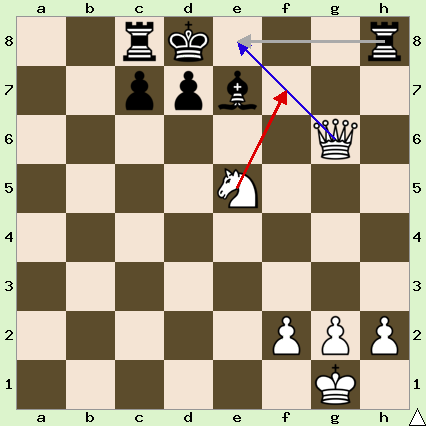
White can sacrifice his queen to create checkmate.
White can play such a brilliant move with the queen, which is to move it to e8, completely leaving it hanging and attacked while delivering check to Black's king. The only move that Black can legally play would be to take the queen with the rook.
This move then allows White to move the knight to the e7 square, delivering the check again. The king cannot move anywhere, because it is blocked by all of its pieces, and the knight cannot be captured, so this is a checkmate and white wins. Such a checkmate like this is known as the Smothered Mate.
All of the chess diagrams were created on Apronus which are free for non-commercial use.






